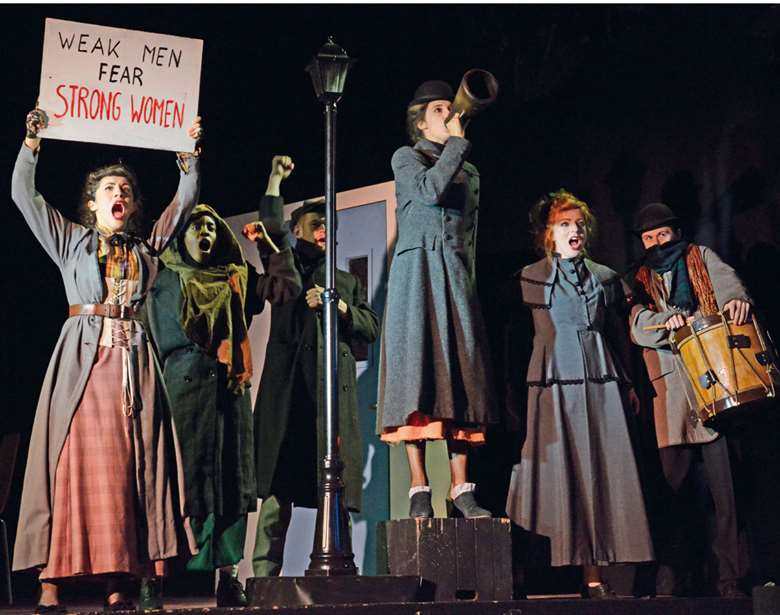Play for performance: Jekyll and Hyde
Evan Placey
Tuesday, September 1, 2020
Each issue of D&T we bring you a page-to-stage focus on a play for performance with your students. This issue, Louise Peacock, Associate Professor and Head of Drama at De Montfort University, shares her experience of mounting a socially distanced production of Jekyll and Hyde

NOBBY CLARK
In Jekyll and Hyde Evan Placey reimagines Robert Louis Stevenson's novella. Originally written for the National Youth Theatre, the play offers a wide range of parts and its setting collides Victorian and 21st Century London, offering exciting opportunities for staging. The play focuses not on Edward Jekyll, Stevenson's protagonist, but on his widow, Harriet Jekyll, who is determined to continue her husband's research despite the resistance of his fellow scientists. This refocusing allows the play to explore how gender roles can restrict us: a topic which speaks readily to young actors. Placey's intention was to place the almost invisible female characters of the novel at the heart of the play.
Opportunities for actresses
As Hyde is now female, so too is Jekyll – enter Flossie Hyde: a rebellious, brave, difficult character. In our production, the part was divided between 5 actors, to allow each to present a different aspect of Hyde's character, coming together to create a powerful character who will stop at nothing to get her way. However, the masterstroke of Placey's play is to create an overlap between Victorian England and the 21st Century so that the modern world intrudes increasingly into the lives of the Victorians and the audience is encouraged to see the parallels between the position in society of women then and now. In contemporary London another character, Florence Monroe, blogs about the story of Harriet Jekyll and uses it to stir up violence against the patriarchy.
It was this combination of past and present, together with a strong cast of male and female roles that made the play a good choice for the Leicester Curve and De Montfort University Coproduction for 2020. The number of characters in the play is 31 (22 female and 9 male) but there is flexibility for doubling roles and for creating a chorus-like ensemble to convey the physical world of the play. In this production a diverse cast of 23 presented the play. The original director of the show, Andy Reeves, took an ensemble approach to building the world of the play, which brought it to life and gave creative opportunities even to those with smaller parts. The shifts and collisions between the 19th Century and the present mean that the staging needs to be fluid, but before final decisions could be made about how to stage the play, Covid-19 intervened. With the Curve Theatre closed, I took responsibility for finding a way to present the play in a safe, socially distanced way.
Social distancing
Initially our aim was to create a live-streamed version of the play, but difficulties with the internet meant that ultimately the students and I chose to focus on bringing an audio version to life. While it was disappointing to lose the wonderful physical opportunities the text offers, for example in the pub scenes and the protest scenes, we had to find a way to make the play work through sound alone.
Inevitably, the rehearsal process underwent a significant shift. Rather than prioritising movement and physical characterisation, the young actors had to focus on the text and on audible ways to suggest character. They experimented with accents and with the pace and tone of their delivery. They used apps such Anchor to rehearse, record and edit their lines.
While it is clear from the stage directions that usually the physical action would be just as important as the lines, particularly in scenes depicting Hyde's violence, the power of the text ensured that the story and the themes were communicated aurally. In consultation with Nick Hern Books we agreed to use narration, often drawn from Placey's stage directions, to help the listening audience understand key actions. In the script, scene 6 is conveyed entirely by stage directions and, as such, would usually be a strong visual depiction of Harriet Jekyll working in her husband's laboratory. In the audio version, Placey's stage directions were used as narration and sound affects were added.
The play presents a challenging argument about the ways in which women are so often marginalised but capable of so much. The female roles provide wonderful challenges for young women. They are strong, intelligent, loud, brave roles and the three central characters of Jekyll, Hyde and Monroe power the narrative onwards. The opportunities provided by the male roles are also very interesting for young actors, running counter to the traditional idea that men must be in control. The men in the story would very much like to be in charge of events but time and again they are triumphed over by the women and so the young male actors have to work with nuance and ambiguity. Overall notions of misunderstanding and misjudging run throughout the play highlighting the importance of neither pre-judging nor underestimating anyone.
Rights to perform Jekyll & Hyde can be arranged with Nick Hern Books: www.nickhernbooks.co.uk/plays-to-perform/jekyll-hyde

